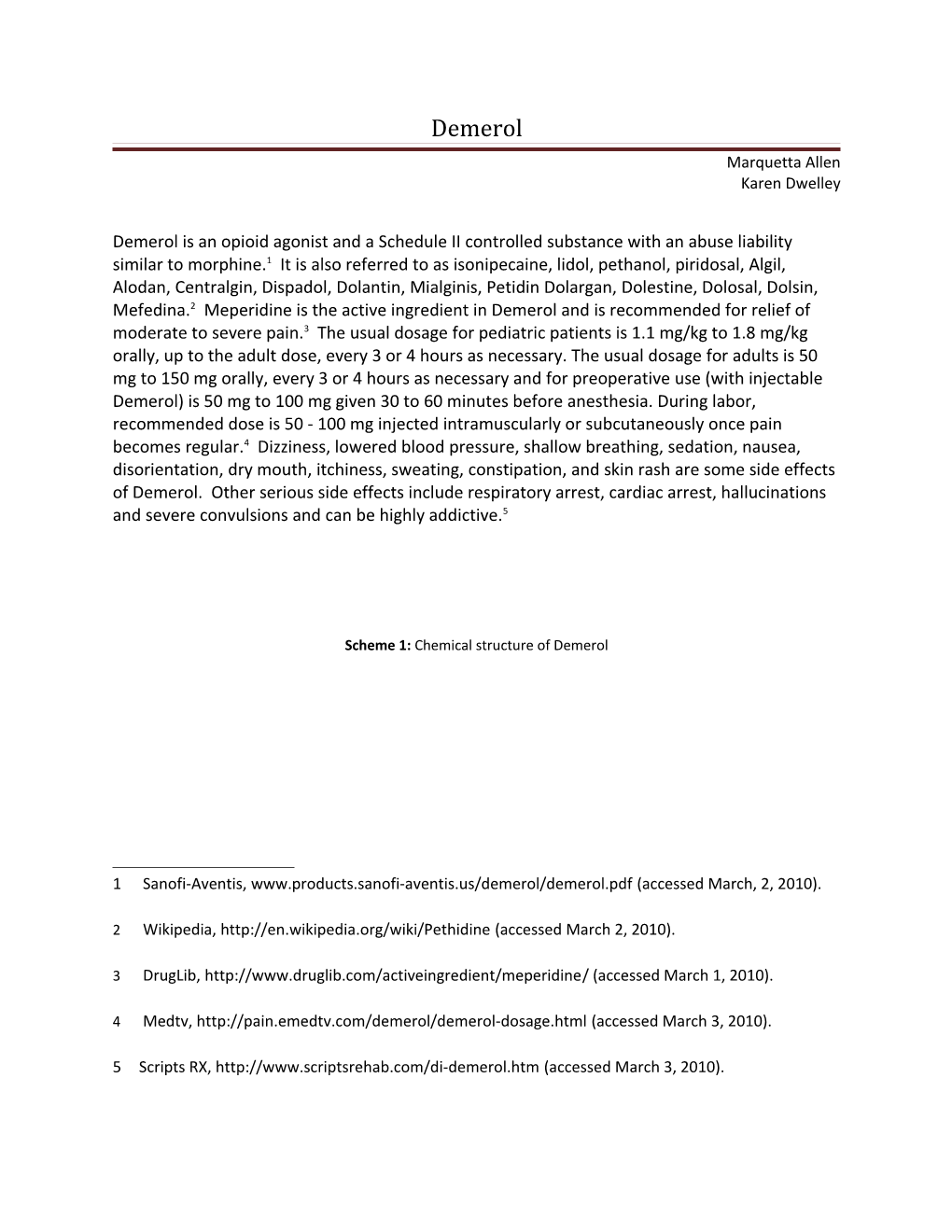Demerol
Marquetta Allen
Karen Dwelley
Demerol is an opioid agonist and a Schedule II controlled substance with an abuse liability similar to morphine.[1] It is also referred to as isonipecaine, lidol, pethanol, piridosal, Algil, Alodan, Centralgin, Dispadol, Dolantin, Mialginis, Petidin Dolargan, Dolestine, Dolosal, Dolsin, Mefedina.[2] Meperidine is the active ingredient in Demerol and is recommended for relief of moderate to severe pain.[3] The usual dosage for pediatric patients is 1.1mg/kg to 1.8 mg/kg orally, up to the adult dose, every 3 or 4 hours as necessary. The usual dosage for adults is 50mg to 150mg orally, every 3 or 4 hours as necessary and for preoperative use (with injectable Demerol) is 50mg to 100mg given 30 to 60 minutes before anesthesia. During labor, recommended dose is 50 - 100mg injected intramuscularly or subcutaneously once pain becomes regular.[4] Dizziness, lowered blood pressure, shallow breathing, sedation, nausea, disorientation, dry mouth, itchiness, sweating, constipation, and skin rash are some side effects of Demerol. Other serious side effects include respiratory arrest, cardiac arrest, hallucinations and severe convulsions and can be highly addictive.[5]
Scheme 1: Chemical structure of Demerol
1H NMR (free base): δ 7.47 (d, J = 2.4 Hz, 1H), 7.39 (d, J = 8.4 Hz, 1H), 7.23 (dd, J = 2.0 Hz, J = 8.4 Hz, 1H), 4.04 (t, J = 6.6 Hz, 2H), 2.79 (br s, 2H), 2.56 (d, J = 13.2 Hz, 2H), 2.28 (s, 3H), 2.16 (m, 2H), 1.96 (m, 2H), 1.59 (m, 2H), 0.86 (t, J = 7.6 Hz, 3H).[6]
13C NMR (free base): δ 173.5, 136.6, 131.2, 130.4, 128.2, 125.4, 66.8, 53.2, 48.3, 46.1, 33.6, 21.8, 10.3. Anal. Calcd for C16H21NO2Cl2·HCl·H2O: C, 49.95; H, 6.29; N, 3.64. Found: C, 50.19; H, 6.00; N, 3.70.[7]
Figure 1. Mass Spectum of Meperidine (EI, from the National Institute of Standards and Technology[8])
There are many different ways to synthesize Meperidine, the active ingredient in Demerol. In past years before Meperidine introduced Pethidine was well known for its potent pain relieving activity. The 4-phenylpiperidine compound originally had the formula of an alkoxyaryl, with diphenylmethoxy group.[9] The more recent way of synthesizing the drug is through a generic approach by aryl-substituted derivatives. That simply means converting the nitriles in the form N-methyl-4-aryl-4-poperidine-4-carbonitriles to ethyl esters, or synthesizing a methyl or a halogen group along with the phenol of the structure. Synthesizing a methyl or a halogen group along with the phenol basically increases the affinity of where and what sites in the body Meperidine will be transported to when it enters the brain.[10] The transporters that carry Meperidine to the sites are commonly referred to as DAT or the dopamine transporter, NET the norepinephrine transporter, and SERT the serotonin transporter.[11]
Scheme 2: Reagents and conditions: (a) BrCH2CH(OCH3)2, NaNH2, toluene. (b) 3N HCl, 50 °C, 4.5 h. (c) CH3NH2•HCl, CH3OH, NaBH3CN. (d) H2SO4/H2O 120 °C; then EtOH, azeotropic distillation.
[1] Sanofi-Aventis, (accessed March, 2, 2010).
[2] Wikipedia, (accessed March 2, 2010).
[3] DrugLib, March 1, 2010).
[4] Medtv, (accessed March 3,2010).
[5] Scripts RX, March 3, 2010).
[6] Lomenzo et al. Synthesis and Biological Evaluation of Meperidine Analogues at Monoamine Transporters. J. Med. Chem.2005, 1336-1338.
[7] Wikipedia, (accessed March 5, 2010).
[8]NIST Chemistry WebBook, Type=Mass (accessed March 5, 2010).
[9]Eisleb, O. New Synthesis of Sodium Amide. Berichte1941, pp 2-3.
[10]Lomenzo et al. Synthesis and Biological Evaluation of Meperidine Analogues at Monoamine Transporters. J. Med. Chem., 2005, 1336-1338.
[11]Shevd, K. Low-dose intrathecal meperidine for lower limb surgery.Can. J. Anesthesia 2005, 26-27.
